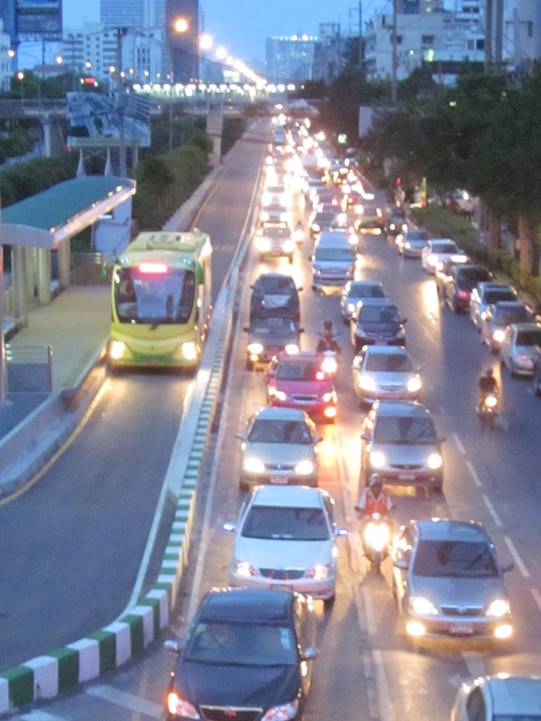Efficient and equitable urban roadway management favors higher value trips and more space-efficient modes over lower-value trips and space-intensive modes. This can justify bus lane networks in most major cities.

Next month I will present a paper at the Thredbo International Conference on Land Passenger Transportation titled, When is a Bus Lane Warranted? It examines where dedicated bus lanes are justified based on economic efficiency and social equity principles. This is an important and timely issue for cities around the world.
Cities are, by definition, places where many people and activities locate close together, so urban space is always scarce and valuable. As a result, efficient and equitable urban roadway management favors higher value trips and more space-efficient modes over lower-value trips and space-intensive modes.

Bus lanes are a practical way to do this. They can carry an order of magnitude more people than a general traffic lane (see image below), and help achieve social equity objectives by ensuring that non-drivers are able to use a fair share of public road space, and helping physically, economically and socially disadvantaged people access economic opportunities. As Enrique Penalosa explains in this TED Talk, bus priority lanes, represent democracy in action by allocating public road space to poor as well as affluent residents.

Although a single bus lane may seem to provide only modest direct benefits, an integrated bus lane network implemented with other pro-transit policies can be the fastest and most cost-effective way of creating more multimodal cities where travellers choose the most efficient mode for each trip: walking and cycling for local errands, public transit when travelling on busy corridors, and driving only when it is most efficient overall, considering all impacts. Unfortunately, current transportation evaluation methods are unsuited to such analysis. Conventional traffic models tend to underestimate the impacts that high quality public transit and transit-oriented development have on automobile ownership and use, and conventional economic evaluation tends to overlook or undervalue many resulting benefits such as parking cost savings, increased traffic safety, and reduced chauffeuring burdens. We need better tools to help decision-makers decide when to implement bus lanes. The following table lists various types of benefits and costs that should be considered when evaluating public transit improvements, including dedicated bus lanes.
Public Transit Benefits and Costs
|
Category |
Improved Transit Service |
Increased Transit Travel |
Reduced Automobile Travel |
Transit-Oriented Development (TOD) |
|
Indicators |
Service Quality (speed, reliability, comfort, safety, etc.) |
Transit Ridership (passenger-miles or mode share) |
Automobile Travel Reductions |
Portion of Development With TOD Design Features |
|
Benefits |
Improved transit operating efficiency Improved bus passenger travel speed and reliability Option value (the value of having options that may sometime be useful) Equity benefits (since existing users tend to be disadvantaged) |
Direct benefits to new users Increased fare revenue Increased public fitness and health (by stimulating more walking or cycling trips) |
Reduced traffic and parking congestion, and resulting facility cost savings Consumer savings Reduced chauffeuring burdens Increased traffic safety Energy conservation Air and noise pollution reductions |
Additional vehicle travel reductions (“leverage effects”) Improved accessibility, particularly for non-drivers More efficient development (reduced infrastructure costs) Farmland and habitat preservation |
|
Costs |
Higher construction and enforcement costs Increased congestion in other lanes |
More crowded buses |
Reduced automobile business activity |
Various problems associated with denser development |
Bus lanes can have various benefits and costs that should be considered in evaluation. Some of these impacts are indirect and long-term, so their evaluation requires predictive modeling of travel and land development.
An ideal urban transit network provides high-quality service within a ten-minute walk of most homes, jobs and services, which requires a gird of grade-separated rail or bus lines spaced no more than a kilometer apart. Many cities are starting to implement bus lanes and other bus priority strategies. For example, although London is most famous for its subway system and congestion pricing, improving and expanding its bus lane network is a critical component of improving overall transit service quality and regional transport system efficiency. But there is far more potential.
In many situations, bus lane development will increase general traffic lane congestion in the short term, although this will decline over time as more travellers take advantage of the improved transit service, particularly if implemented with other transit-encouragement strategies. Comprehensive evaluation weighs this incremental motorist delay against transit travel time savings (including reduced bus operation and passenger travel time costs), reductions in automobile external costs including downstream traffic and parking congestion, accidents and pollution emissions, the social equity value of improving mobility for non-drivers, plus the strategic value of creating more multimodal transportation systems.

I found no simple warrants that define when bus lanes are justified. My analysis suggests that bus lanes are generally warranted where, after all economically justified pro-transit policies are implemented, they would attract more than 800 peak-hour passengers (about 20 buses) on surface streets or 1,800 peak-hour passengers (about 30 buses) on grade-separated highways, since those lanes carry more passengers than a general traffic lane, and so save total travel time, and by reducing urban-peak automobile travel, they provide additional indirect benefits, including reducing downstream congestion, providing road and parking facility cost savings, and by reducing traffic accidents and pollution emissions. As a result, more comprehensive evaluation can justify extensive bus lane networks in most cities, particularly rapidly-growing cities in developing countries.
What do you think? Are there other impacts and objectives to consider? Are there better ways to determine when bus lanes are justified? Are there better ways to communicate the value of high quality transit and pro-transit policies to decision-makers and the general public?

Planetizen Federal Action Tracker
A weekly monitor of how Trump’s orders and actions are impacting planners and planning in America.

Chicago’s Ghost Rails
Just beneath the surface of the modern city lie the remnants of its expansive early 20th-century streetcar system.

Amtrak Cutting Jobs, Funding to High-Speed Rail
The agency plans to cut 10 percent of its workforce and has confirmed it will not fund new high-speed rail projects.

Ohio Forces Data Centers to Prepay for Power
Utilities are calling on states to hold data center operators responsible for new energy demands to prevent leaving consumers on the hook for their bills.

MARTA CEO Steps Down Amid Citizenship Concerns
MARTA’s board announced Thursday that its chief, who is from Canada, is resigning due to questions about his immigration status.

Silicon Valley ‘Bike Superhighway’ Awarded $14M State Grant
A Caltrans grant brings the 10-mile Central Bikeway project connecting Santa Clara and East San Jose closer to fruition.
Urban Design for Planners 1: Software Tools
This six-course series explores essential urban design concepts using open source software and equips planners with the tools they need to participate fully in the urban design process.
Planning for Universal Design
Learn the tools for implementing Universal Design in planning regulations.
Caltrans
City of Fort Worth
Mpact (founded as Rail~Volution)
City of Camden Redevelopment Agency
City of Astoria
City of Portland
City of Laramie






























